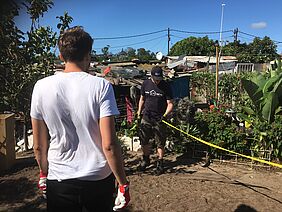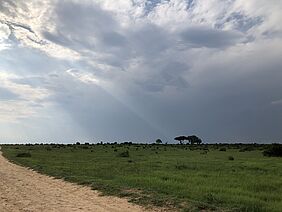As Khustas property was jam-packed with plants, collected materials and small bowers the first task was to create space for working and the structure we were going to implement. Creating space in this case meant the removal (and transplantation) of plants and trees, the dismantling of bowers, the relocation of material Khusta wanted to keep, the dumping of material he wanted to throw and the overall clearing and cleaning of the site. Faster than expected the property looked like a construction site and we were able to start digging. The unfortunate fact was that we did not only dig up soil, we also found a lot of … interesting things. Among all the plastics, wires and tiles were also socks, underwear, a toy gun and an old garden dump with half rotten banana plants.
While the site team was busy digging up trash and treasures, the work at Makerspace continued steadily. The production of rafters was running like a conveyor belt, accompanied by the noise of the always-running planer, the screeching of the grinder and the crackling of the welding machine. Even the drilling noise from the metal frames did not lapse into silence throughout the whole week.
The noisiness of the Makerspace found its counterpart in the sound of the concrete truck pouring the concrete into wheel barrows. As we only have a path with the width of 1.10 meters we had to take the concrete to the prepared foundation formwork with muscle power. The boys turned into machines beating the speed of the concrete truck. In basically no time the foundations were poured, compressed and leveled. The second load followed in the afternoon of the following day. It was supposed to be delivered ion the morning, but hey, we are still in South Africa. At least everyone of the site team got to know the real South African experience of „Waiting“ now. To not fall asleep the last two foundations were “race-digged“, the last formwork was more or less improvised and Lady, Khustas dog, got a lot of attention.
After the last foundation was poured, the last pole for the day was planed and the not-even-close-to-last hole of the metal frames was drilled, we called it a day. The next day would offer a chance to sleep-in and relax in the morning. The long expected visit of the Nelson Mandela Bay Stadium was finally due. As Silke (Prof. Flassnoecker) was part of the team that designed and realised the stadium before the World Cup, the tour was not of the standard type. The focus was set on the structure, the geometry and the building process. And a bit of complaining over FIFA.
Complaints were definitely not made about “our“ place, or rather Janets place. Saturday evening we all met here and we showed them our second home. After a long evening we decided to only leave around nine the next morning for Addo. Addo Elephant National Park is the third largest National Park in South Africa, and the largest that is only in South Africa. After the rain of the past days Addo appeared completely different than the times before. There was no burned grass, no dry bush, everything was lush and green, flowers were growing everywhere. Probably all the green fields where the reason why we saw heaps of zebras and antelopes despite temperatures exceeding the forty degrees. Only the elephants were a bit rarer than we have experienced it before.
Full of impressions of zebras and elephants right next to our car, buffalos closer than ever and antelopes jumping around the car we left Addo late in the afternoon and gathered again at King’s Beach in PE for the ending of the day.
019_Parts and Progress
Back


